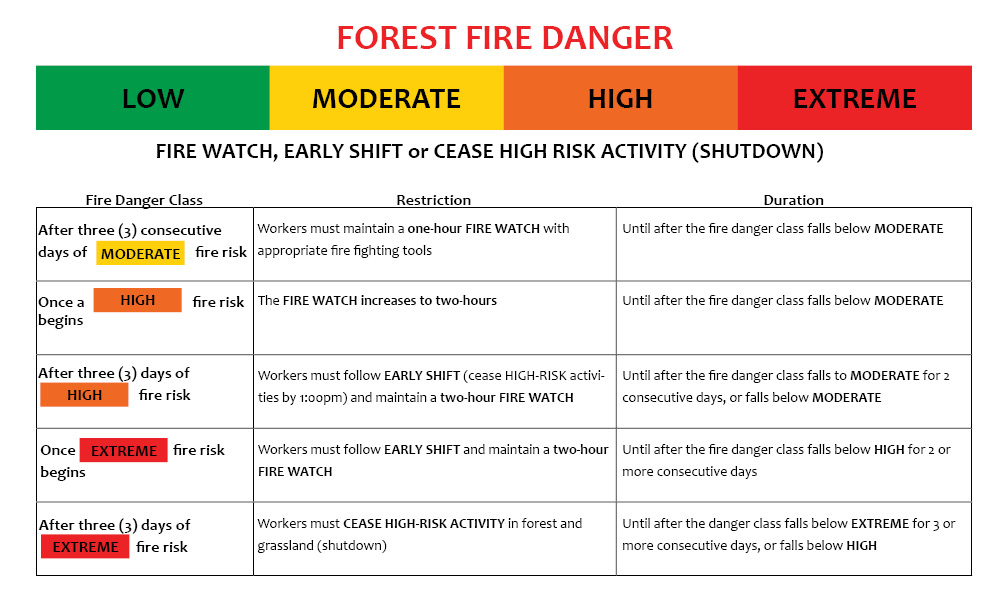Wildfires can start and spread quickly. Learn how you can reduce the risk of wildfires, and what you can and can't do during higher-risk forest fire danger periods.
The following "cheat sheet" explains each high-risk hazard. See the table below the image for an accessible version of the cheat sheet:
Image

| Fire Danger Class | Restriction | Duration |
|---|---|---|
| After three (3) consecutive days of MODERATE fire risk | Workers must maintain a one-hour FIRE WATCH with appropriate fire fighting tools | Until after the fire danger class falls below MODERATE |
| Once a HIGH fire risk begins | The FIRE WATCH increases to two hours | Until after the fire danger class falls below MODERATE |
| After three (3) days of HIGH fire risk | Workers must follow EARLY SHIFT (cease HIGH-RISK activities by 1:00pm) and maintain a two-hour FIRE WATCH | Until after the fire danger class falls to MODERATE for 2 consecutive days, or falls below MODERATE |
| Once EXTREME fire-risk begins | Workers must follow EARLY SHIFT and maintain a two-hour FIRE WATCH | Until after the fire danger class falls below HIGH for 2 or more consecutive days |
| After three (3) days of EXTREME fire risk | Workers must CEASE HIGH-RISK ACTIVITY in forest and grassland (shutdown) | Until after the danger class falls below EXTREME for 3 or more consecutive days, or falls below HIGH |
High-risk activities
- Mechanical brushing.
- Disk trenching.
- Preparation or use of explosives (e.g. fireworks, blasting).
- Using fire- or spark-producing tools, including cutting tools (e.g. grinders, cutting torches)
- Using or preparing fireworks or pyrotechnics; (e.g. fireworks, blasting)
- Grinding, including rail grinding.
- Mechanical land clearing (e.g. excavator, skidder)
- Clearing and maintaining rights of way, including commercial right of way grass mowing (residential lawn mowing is not included)
- Any of the following activities carried out in a cut block, excluding a road, landing, roadside work area or log sort area in the cut block:
- Operating a power saw (unless on a landing)
- Mechanical tree felling, woody debris piling or tree processing, including de-limbing
- Welding.
- Portable wood chipping, milling, processing or manufacturing (unless on a landing)
- Skidding logs or log forwarding unless it is improbable that the skidding or forwarding will result in the equipment contacting rock.
- 6- Yarding logs using cable systems.
What is Early Shift and when does it start?
- Early Shift means all high-risk activities must stop by 1 p.m.
- After three consecutive days of HIGH, all high-risk activities must cease by 1 p.m.
- After three consecutive days of EXTREME, cease all activities.
What are the responsibilities of a Fire Watcher?
A Fire Watcher:
- Can reasonably see the site of the high-risk activity during the time the fire watcher is required.
- Has at least one firefighting hand tool.
- Actively watches and patrols for sparks and fires on the site of the high risk activity.
- Immediately carries out fire control and extinguishes the fire, if practicable.
- Has the means on site to report the fire (landline or cellular).
